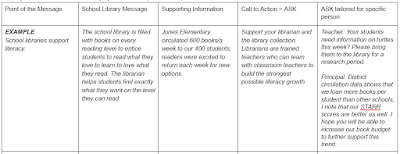By Dorcas Hand, Editor TASLTalks
As Texas school librarians gear up for ESSA conversations
(and normal school library advocacy), we are thinking how to explain to our
stakeholders, allies and curious people what we do and why it matters. We know
it does – but what metrics can we show to prove it? Read first to understand the big questions, but be sure to answer the survey (GoogleForm) to help us understand statewide trends. Thank you already!
Traditionally, we cite our circulation statistics as a
reliable measure of our impact on students. It is always important when citing
any data to explain to readers how it explains the point you are making – just knowing
that lots or few books were borrowed doesn’t tell any story without
explanation. Does few books tell us that there is no librarian helping students
find the right books, or does it tell us that there are no books?
Along that line of thought, I note that circ statistics in
high schools may not tell anything about how much students are reading because students
in high school are more likely to interact with library resources in digital
formats, whether ebooks, digital subscription tools including TexQuest, or
internet searches with librarian guidance or independently. So, if I want to
tie my work as a librarian to student literacy rates or test scores or anything,
I need a new data set. That exact question is how I came to this blog post: how
can we talk about high school libraries in Houston ISD?
Students Need Libraries in HISD has been looking at campus
circulation as a way to illustrate which campuses have librarians, how much
access to book borrowing the students have, and which campuses contribute to
student experience of book deserts. In grades K-8, those circ statistics offer
a bare bones understanding of a campus literacy culture. But in high school,
that analysis falls apart because there are not reliable metrics in place to
illustrate student access to library sponsored resources, or teaching. We’ve
all seen the trends that show few high school students are big readers – but
more of them ARE big library users, especially if they have no internet or device at home. And especially when they have a librarian who teaches them how
to find the most useful resources and ebooks to accomplish their assignments
and to learn to be learners.
So, now I’m curious. How could I see student library use in
data I already have? And what data might I wish to have if I want my metrics to
be more useful? What do I want to know? Hmmm.
First, I
want to know what resources the school campus offers students:
- ebooks? Overdrive, BrainHive, Follett, Mackin, or another vendor?
- Does the campus have access to TexQuest resources?
- Does the district subscribe directly to other digital tools for students? Does the campus have individual subscriptions, beyond district selections?
- Does the campus have a learning management system to organize and advertise the variety of available digital tools?
And now I
want to know what use is made of these resources:
- Does the librarian offer use statistics for ebooks to the principal or district, or PTA, to explain how important these budget items are to literacy growth?
- Can the campus track its own students’ use of TexQuest resources? This does require that the campus register individually under the district aegis; without that campus level indivuation, only district stats are possible.
- If the district offers additional databases, do campuses have separate logins to see local use? Or are stats only counted at the district level?
- If a campus has individual digital subscriptions, it absolutely can track the stats – does it?
- All of these “is/does a campus…” questions raise the additional set of wonders:
- Is there a librarian to publicize the digital tools and their access?
- Does that librarian manage the usernames and passwords for easiest student use?
- Does that librarian TEACH how and why to use the resources for best results, including choosing the right tool for the assignment?
- If there is a campus learning management system, who controls its content?
- Does the librarian have control to post links and access info to the databases?
- Can the librarian work with other teachers to embed these links in specific assignments to remind students that these tools are provided for their learning.
- How can a librarian or principal count the effect of those postings to better understand the academic effects of strong digital support structures?
For today, I’m going to leave you with just these questions.
I’d like to enlist your help in understanding how we might answer them, how to
develop policies that support improved metrics for digital resource use
statistics. Here is a GoogleForm SURVEY to see what folks in Texas are already
doing – PLEASE contribute your answers. And please realize that no districts
have robust reporting yet to answer all these questions – and there is no
identification required, beyond your ESC region.
If anyone is interested in moving this forward with me,
please be in touch – this has potential to be a big project!






